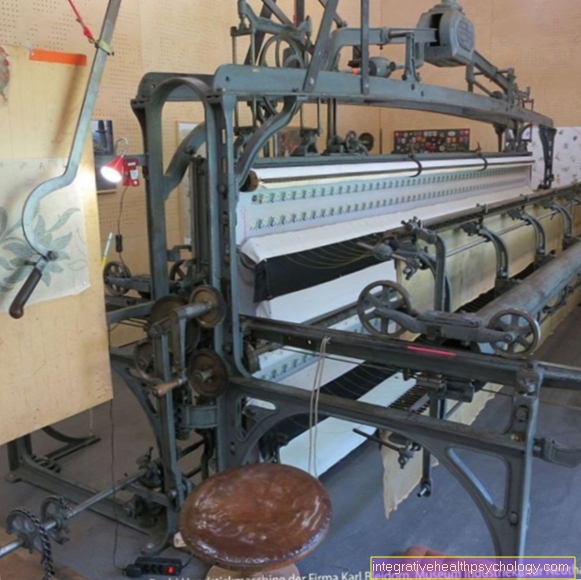Coarctation of the aorta
Synonyms in the broadest sense
Narrowing of the main artery of the body, narrowing of the aorta, coarctatio aortae
English: stenosis of the aortic isthmus, coarctation of the aorta, aortic coarctation
definition
Coarctation of the aorta is a narrowing of the main artery (aorta). This is narrowed after it emerges from the heart and after the branching off of the artery that supplies the upper half of the body. In this area, the main artery makes an arch, which is why one speaks of the aortic arch.

The different forms
There is a child and an adult form of vascular changes in the main artery. In the child's form, coarctation of the aorta is present from birth and there are usually other heart defects. Approx. 7% of all congenital heart defects are coarctation of the aorta.
Adults (adult form) with a narrowed aorta have acquired these vasculature, i.e. it has not existed since birth. Concomitant diseases of the heart are rare with this form of coarctation of the aorta.
The stenosis in the baby
At 6 to 10%, coarctation of the aorta is one of the most common heart defects in newborns. There are different forms of aortic coarctation, which differ anatomically. The vascular constriction is often in front of the confluence of the ductus arteriosus (a structure from the embryonic blood circulation) into the aorta. This form is called preductal coarctation of the aorta. More rarely, the stenosis is behind the confluence of the ductus ateriosus with the aorta. Then one speaks of the post-ductal aortic coarctation.
If a newborn suffers from preductal isthmus coarctation, a life-threatening situation can arise because the ductus arteriosus closes shortly after birth. The ductus arteriosus supplies the lower half of the body in the unborn child with blood. In the case of preductal isthmus coarctation, it is therefore important to give the drug prostaglandin to reopen the ductus arterious and keep it open.
Depending on how severe the stenosis is, newborns may show signs of heart failure (heart failure) before the operation: increased sweating, accelerated breathing, poor drinking and failure to thrive. If a newborn is born with a pronounced coarctation of the aorta, the child can show shock-like deterioration. In newborns and infants, it is therefore important to detect coarctation of the aorta as early as possible and to initiate relieving therapy.
The symptoms
Given changes in the main artery, high blood pressure can occur. Normally, the blood pressure in the legs or the lower half of the body is 30-40 mmHg higher than in the arms or the upper half of the body, but this is exactly the opposite in coarctation of the aorta.
The narrowing of the aorta results in an inverse difference in blood pressure between the arms and legs. The blood pressure in the vascular system is increased in the section in front of the constriction and decreased after the constriction. Coarctation of the aorta is also referred to as hypertension of the upper extremities with the symptoms of headache, dizziness, nosebleeds (nosebleeds can also occur in connection with headaches) and a throbbing sensation in the head area. The blood pressure values in the lower half of the body are lowered (hypotension) and weakness in the legs or even reduced blood supply to the legs can occur.
Blood pressure difference
A difference in blood pressure can be a symptom of coarctation of the aorta. This means that there is a marked difference in blood pressure between the arms and the legs. This pulse deficit is the main symptom of coarctation of the aorta and is noticeable for those affected by having warm hands but cold feet, for example.
The diagnosis
The difference in blood pressure between the arms and legs is a clear indication of coarctation of the aorta. If the patient reports symptoms such as headache, throbbing pain, dizziness and weakness in the legs, he should be examined for such a vascular narrowing.
With the help of an X-ray of the chest it is possible to recognize coarctation of the aorta: The left side of the heart is enlarged and a stronger representation of the main artery may be seen.
With a special ultrasound examination of the esophagus, the heart and the arteries can be examined in detail and the narrowing of the aorta can be determined. With a cardiac catheter examination, the location of the vascular narrowing can be precisely determined and a treatment attempt can be carried out at the same time (see under treatment).
Find out more about the topic here: Cardiac catheter examination.
Echocardiography
Echocardiography is the examination method of choice for newborns, infants and young children. With the heart ultrasound examination one has a certainty of 95% and more to make the diagnosis of coarctation of the aorta. In addition, the severity of the stenosis can be determined during the examination and further malformations of the heart can be revealed.
For more information, read on: Echocardiography.
Auskulation
As part of coarctation of the aorta, a heart murmur can be auscultated with the stethoscope. Experienced paediatricians and pediatric cardiologists record a medium-frequency systolic. A systolic is a heart murmur that occurs during the ejection phase (systole) of the heart cycle. The systolic can be heard in coarctation of the aorta to the left of the sternum, in the armpit and on the back.
The therapy
To correct the coarctation of the aorta, an operative procedure is necessary, with the help of which the constriction is removed. After the vascular constriction has been removed, the blood pressure is usually low. A vascular prosthesis can be used here or the two vascular stumps can be directly connected to one another again.
In the case of children with coarctation of the aorta, the operation should be carried out as early as possible, because the longer the vascular narrowing, the more likely it is that the high blood pressure will not recede.
An alternative to surgery, especially in adults, is to dilate the constriction in the vessel with a balloon. This balloon is advanced through a catheter to the aorta, then inflated and then pushes the vessel walls outwards. The balloon can also widen the vessel if there is still a residual narrowing of the vessel after the operation or if the vessel has narrowed again although it was optimally widened by the operation.
Prognosis
If a patient with coarctation of the aorta is treated late, the main complications are the development of cardiac insufficiency or aortic valve disease or a tear in the main artery. If, on the other hand, the operation is carried out early, the risk of secondary diseases in the cardiovascular system can be reduced.
Compared to the healthy population, patients with coarctation of the aorta are more likely to die of high blood pressure or other cardiovascular diseases.
What is the life expectancy with coarctation of the aorta?
Coarctation of the aorta (ISTA) is a common heart defect that can be corrected surgically. In addition, interventional procedures with balloon dilatation and stent implantation are used. Both the operative and the interventional therapy of an ISTA are used as standard and have a very good chance of success. In some cases, high blood pressure values persist after the operation, which can be treated well with medication.
A residual risk of a renewed narrowing in the area of the aortic isthmus remains, so that control examinations are necessary. Most children born with coarctation of the aorta later lead an unrestricted life. The life expectancy of a coarctation of the aorta is comparable with the life expectancy of the normal population after a successful correction of the heart defect.
The bypass cycle of an unborn child
In the unborn child, the fetus, there are special features in the cardiovascular system. One speaks of the fetal circuit or bypass circuit. This is necessary because the lungs in the unborn child are not yet fully developed, which means that the pulmonary circulation does not yet function as it does in adults.
The child receives the oxygen-rich blood from the mother via the umbilical vein, which is connected to the placenta (placenta). This runs as a so-called "ductus venosus Arantii" into the lower vena cava and bypasses the portal system. There is a right-left shunt in the heart of the fetus. The blood flows from the right heart, bypassing the pulmonary circulation, via the "foramen ovale" directly into the left heart and from here it is pumped into the body circulation. The fetus finally releases its blood back to the placenta through the umbilical arteries.
After the birth, the lungs unfold and the pulmonary circulation opens up. This results in changed pressures and various connections in the bypass circuit are passively closed.





























